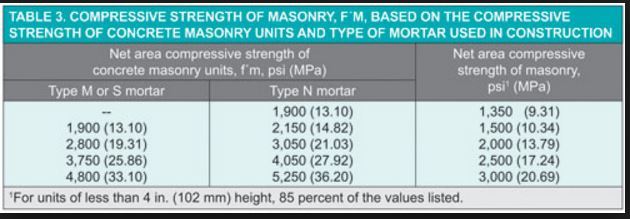Navigation
Install the app
How to install the app on iOS
Follow along with the video below to see how to install our site as a web app on your home screen.
Note: This feature may not be available in some browsers.
More options
Style variation
-
Congratulations TugboatEng on being selected by the Eng-Tips community for having the most helpful posts in the forums last week. Way to Go!
You are using an out of date browser. It may not display this or other websites correctly.
You should upgrade or use an alternative browser.
You should upgrade or use an alternative browser.
ACI 530.1 05 Table 2 1
- Thread starter Hoboneer
- Start date
- Status
- Not open for further replies.
- Thread starter
- #5
I suppose I didn't phrase my question clearly. Let me try again. ACI 530.1 Table 2 has 3 columns. The first column lists various psi block (1,900 2,800 3,750 4,800) combined with type M or type S. The second column lists DIFFERENT various psi block (1,900 2,125 3,050 4,050 5,250) combined with type N. So the question is why the different psi block for type N? What if I want to combine 2,150 with type S, for example?
-
1
- #6
Well this table is labeled Table 3 but it has the same numbers you reference:

This table lists in the left two columns several types of BLOCKS (or as the table states - UNITS) and their associated net compressive strength. These
are the compressive strength of ONLY the block itself - not the MASONRY which combines blocks with mortar.
The far right column is the design compressive strength f'm of the MASONRY (i.e. blocks combined with mortar).
So if you are using blocks that provide 1900 psi strength (block only strength) and you use type N mortar, your design f'm would be 1350 psi.
So to your question - why the different types of BLOCKS in the left two columns? Probably due to limitations on testing perhaps? You are right - it doesn't make sense.
If you had a block that met the 2800 psi level, and you used Type N mortar - I would think that you'd have to use f'm = 1500 unless ACI 530 mentions interpolation here...which I doubt.
Check out Eng-Tips Forum's Policies here:
faq731-376

This table lists in the left two columns several types of BLOCKS (or as the table states - UNITS) and their associated net compressive strength. These
are the compressive strength of ONLY the block itself - not the MASONRY which combines blocks with mortar.
The far right column is the design compressive strength f'm of the MASONRY (i.e. blocks combined with mortar).
So if you are using blocks that provide 1900 psi strength (block only strength) and you use type N mortar, your design f'm would be 1350 psi.
So to your question - why the different types of BLOCKS in the left two columns? Probably due to limitations on testing perhaps? You are right - it doesn't make sense.
If you had a block that met the 2800 psi level, and you used Type N mortar - I would think that you'd have to use f'm = 1500 unless ACI 530 mentions interpolation here...which I doubt.
Check out Eng-Tips Forum's Policies here:
faq731-376
- Thread starter
- #7
Staneer - one thing that "might" explain it a little - if you read the commentary in 530.1-11 they show a graph plot of various points showing the relationship between compressive strength of units vs. compressive strength of masonry separated by mortar type. (see Figure SC-2 on page S-17). This plot creates two separate lines - one for M and S mortar and one for N mortar.
To define the lines, Table 2 must have simply used numbers from that plot to define the relationships, perhaps rounding up or down to get close to "typical" block strengths.
Check out Eng-Tips Forum's Policies here:
faq731-376
To define the lines, Table 2 must have simply used numbers from that plot to define the relationships, perhaps rounding up or down to get close to "typical" block strengths.
Check out Eng-Tips Forum's Policies here:
faq731-376
- Status
- Not open for further replies.
Similar threads
- Replies
- 2
- Views
- 2K
- Replies
- 7
- Views
- 14K
- Replies
- 1
- Views
- 8K
- Locked
- Question
- Replies
- 5
- Views
- 4K
- Replies
- 1
- Views
- 4K
